

by Tony Wrenn, Hon. AIA
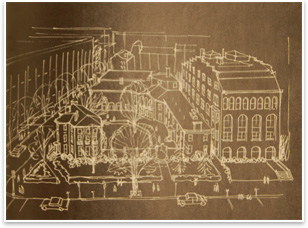 Times were
relatively good and administrative space tight for the AIA national
component, so leaders were planning a new national headquarters
building to “satisfy both physical and spiritual
functions—a building of special architectural significance,
establishing a symbol of the creative genius of our time yet
complementing, protecting and preserving a cherished symbol of
another time, the historic Octagon House.”
Times were
relatively good and administrative space tight for the AIA national
component, so leaders were planning a new national headquarters
building to “satisfy both physical and spiritual
functions—a building of special architectural significance,
establishing a symbol of the creative genius of our time yet
complementing, protecting and preserving a cherished symbol of
another time, the historic Octagon House.”
The initial design competition selection, by
Mitchell/Giurgola—a five-story red brick building that
featured a semi-circular mostly glass wall that embraced The
Octagon House and garden provided insufficient space and, after
acquisition of an adjacent 19th century building on New York
Avenue, the AIA asked for a new design. The AIA approved the
resulting 130,000-square-foot proposal at its 1967 convention, but
the U.S. Commission of Fine Arts thought it did not complement The
Octagon and rejected it and the follow-up revision.
Mitchell/Giurgola withdrew.
A new AIA selection committee, with Max Urbahn as chair and the
first, second, and third place winners of the initial competition
among its members—Romaldo Giurgola, I. M. Pei, and Phillip
Will Jr., respectively—began interviewing for a new architect.
They announced their selection May 14, 1969: The Architects
Collaborative (TAC), Walter Gropius’ firm in Cambridge, Mass.,
with architects Norman Fletcher and Howard Elkus in charge of
design and construction. Their design was ready for presentation to
the Commission of Fine Arts on May 15, 1970, and the commission
approved.
For the two-year construction phase, from January 1971 to March
1973, national AIA administration was housed at 1785 Massachusetts
Ave., NW, a 1910 building Jean de Sibour and now headquarters of
the National Trust for Historic Preservation.
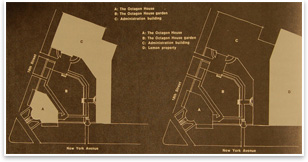 Even as the
Lemon Building, the Octagon Stable, and the 1940s Administration
Building were cleared away, restoration of The Octagon went forward
under the direction of restoration architect J. Everett Fauber Jr.
On March 12, 1973, the AIA began moving into the new headquarters
building at 18th St. and New York Ave., NW, behind The Octagon. In
a press release, the Institute noted “The new seven-story
headquarters building—which will be known as ‘The
Octagon’ [the official name of the historic Tayloe
mansion]—will house the Institute’s 100-person staff on
the first three floors. The remaining four floors will be available
for leasing.” Formal dedication took place in June, to which
that month’s issue of AIA Journal was devoted. The
press-release proclamation aside, the new building was rarely
referred to as The Octagon Building, generally becoming known
simply as the AIA Headquarters Building.
Even as the
Lemon Building, the Octagon Stable, and the 1940s Administration
Building were cleared away, restoration of The Octagon went forward
under the direction of restoration architect J. Everett Fauber Jr.
On March 12, 1973, the AIA began moving into the new headquarters
building at 18th St. and New York Ave., NW, behind The Octagon. In
a press release, the Institute noted “The new seven-story
headquarters building—which will be known as ‘The
Octagon’ [the official name of the historic Tayloe
mansion]—will house the Institute’s 100-person staff on
the first three floors. The remaining four floors will be available
for leasing.” Formal dedication took place in June, to which
that month’s issue of AIA Journal was devoted. The
press-release proclamation aside, the new building was rarely
referred to as The Octagon Building, generally becoming known
simply as the AIA Headquarters Building.
The times they were a-changin’
The decade had begun with a convention in New York in 1967 when AIA
President elect Robert L. Durham noted “We have finished our
‘first 100 years.’” Though the computer age had
arrived and was being touted as a great time saver and asset,
Durham suggested that the architect should be wary and control
technology, for “when we lose our interest in quality and
cannot give our first emphasis to design, we will no longer be
worth of the name AIA.”
Governor Nelson Rockefeller of New York addressed the convention
telling conventioneers “I know of no more important group in
our country today than those assembled here in this gathering. Your
contribution as artists, as builders, as planners, as creators in a
country which will rebuild everything that has been built since the
days of George Washington in the next four years or duplicate what
has been built in the next 40 years is probably the most important
responsibility of any group of men and women in this nation ... You
are determining our future.”
Wallace Harrison won the AIA Gold Medal that year, and Rockefeller
was present for that ceremony as well. He and Harrison, whose
relationship as architect, client, and friends went way back more
than a quarter century obviously formed an obvious mutual
admiration society. Rockefeller had noted that Harrison was
“sensitive to new ideas and new concepts and yet he is not
swept along by every passing fad and fancy in architecture.”
He continued “I can’t help but recall an incident in
1934, I think it was, or ’35, when Wally and his associates in
the Rockefeller Center group had finished designing the central
building from a functional point of view, and then there was a
discussion as to whether this building should be draped in some
architectural style, and my father leaned strongly in this
direction, and Wally contained himself as long as he could and
finally exploded, ‘Damn it, Mr. Rockefeller, you just
can’t do that!’ And he didn’t.”
Harrison was eloquent in his acceptance of the Gold. “In spite
of our poets and prophets, we Americans have weaknesses and like
all humans have permitted the extension of slums, the over-building
of cities, the misuse of the skyscraper, and the automobile making
traffic impossible.
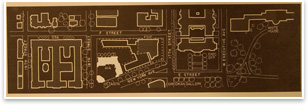 “By now
throwing out the bad parts of science and Victorian materialism and
mechanization, we also have permitted the dividing of races, the
division of the poor classes in the cities and the richer whites in
the suburbs. We have even stood by with small protests while our
sciences have developed the bombs.
“By now
throwing out the bad parts of science and Victorian materialism and
mechanization, we also have permitted the dividing of races, the
division of the poor classes in the cities and the richer whites in
the suburbs. We have even stood by with small protests while our
sciences have developed the bombs.
“But, born hopeful, we architects offer a better
future—new towns; new communities—where in the American
way, rich and poor, black and white, can live together with a new
transportation and a better environment . . . Governor Rockefeller
has shown how the government can use architectural
imagination.”
Rockefeller had been associated with Harrison for 35 years and
called it “one of the happiest and most rewarding association
of my life.”
“Few issues are outside the breadth of Wally Harrison’s
knowledge,” Rockefeller said. “Few subjects are beyond
the reach of his curiosity. Wally Harrison’s interests are as
wide as the world. And they range well beyond the necessities of
his professional discipline.
“And yet, it a wonderfully rewarding way, it is this very
largeness of mind, this wider vision, that elevates his
architecture to greatness ... I am reminded of the time Winston
Churchill said: ‘We shape our buildings; thereafter, they
shape us.’ If this is true, as I suspect it is, then Wally
Harrison has helped to shape our lives to the dimensions of
greatness.”
The AIA of the ’60s preserved . . .
A previous decision of the Institute to oppose the
extension of the West Front of the U.S. Capitol was being
restudied, since some maintained the AIA should not be involved. A
task force appointed by the Board studied the matter and disagreed,
reporting that “architects collectively, i.e., arts
commissions, service action groups, AIA chapters, or the Institute
itself, have an obligation to society to comment constructively on
public issues. Changes to the Capitol are in this category.”
The opposition was renewed “... since the decision to stop
adding to the Capitol must be made at some point, it should be made
now while the last remaining exterior portion of the original
Capitol can be saved as visible evidence of our
heritage.”
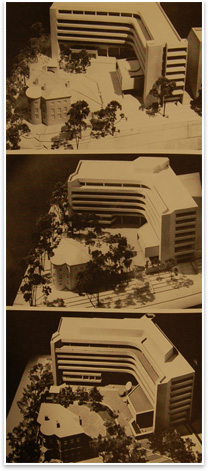 Ultimately—after
more than a decade of statements, congressional and committee
appearances, and a demonstration before the Capitol West Front and
a march up Constitution Ave.—the AIA prevailed. One still
looks from the Mall at a West Front that displays the genius of
architects Thornton, Latrobe, Bulfinch, and Walter and of landscape
architect Frederick Law Olmsted.
Ultimately—after
more than a decade of statements, congressional and committee
appearances, and a demonstration before the Capitol West Front and
a march up Constitution Ave.—the AIA prevailed. One still
looks from the Mall at a West Front that displays the genius of
architects Thornton, Latrobe, Bulfinch, and Walter and of landscape
architect Frederick Law Olmsted.
. . . And persevered
Few AIA convention speeches are more memorable, would be longer
remembered, or bring about more study and introspection than that
of Whitney M. Young Jr., at the 1968 Convention in Portland, Ore.
In starting a lengthy tutorial on civil rights, Young said,
“if I seem to repeat things you have heard before, I do not
apologize, any more than I think a physician would apologize for
giving inoculations. Sometimes we have to give repeated
vaccinations, and we continue to do so until we observe that it has
taken effect ... you are not a profession that has distinguished
itself by your social and civic contributions to the cause of civil
rights, and I am sure this has not come to you as any shock. You
are most distinguished by your thunderous silence and your complete
irrelevance.”
In the discussion period that followed the speech, Young continue
his offensive:
“But the fact happens to remain that out of the 11 hundred AIA
members in New York, only seven are Negro; out of the 8 hundred in
Chicago, only eight are Negro. I don’t know what the other 165
[chapters] look like, but you know. This is not enough ... You are
leaders in your communities, and you are not giving the quality and
the extent to the issue that can be given ... We want you to be
architects of a new morality, of a new national commitment, and
you’ve got to catch up because your forefathers in this field
didn’t do too well, so you have to run faster.”
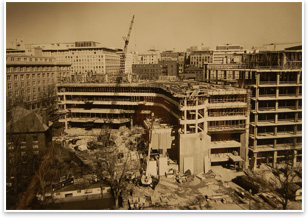 Recognizing
the goring was deserved, AIA commissions, task forces, and studies
on integrating blacks, women, and other minorities into the
practice of architecture, and into the Institute, followed.
Recognizing
the goring was deserved, AIA commissions, task forces, and studies
on integrating blacks, women, and other minorities into the
practice of architecture, and into the Institute, followed.
AIA President George Kassabaum reported in 1969 “The
AIA’s national activities this year have tried to awaken a
collective social conscience in the profession ... we have urged
every chapter to destroy any racial barriers they may have
inherited from past generations ... But though we have tried to
show the way by our national policies and committee actions, your
community will not judge you or your profession by what the
national organization does ... Your community will reach its
decision by what you and your chapter do.”
A longer view elsewhere, too
In 1969, the AIA presented its first Twenty-five Year Award,
established “to recognize a distinguished design after a
period of time has elapsed in which the function, esthetic
statement, and execution can be reassessed.” The first award
went to New York City’s Rockefeller Center, “a project so
vital to the city and alive with its people that it remains as
viable today as when it was built.” The then-17-acre cluster
of 18 buildings on 4 city blocks, little changed, retains that
vitality still.
Among other awards that year was the AIA Allied Professions Medal
to John Skilling, principal-president of Skilling, Helle,
Christiansen, Robertson, structural engineers for the World Trade
Center.
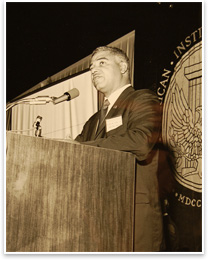 Continuing its
long-established stewardship of monumental Washington, the AIA
broadened its opposition to District of Columbia planning in 1969
to include transportation. “Testimony opposing construction of
an improperly planned and developed freeway system for the District
and environs was delivered before the District of Columbia City
Council and the National Capital Planning Commission.” Though
the opposition was vocal and widely shared, the automobile proved a
powerful opponent. An open cut, which would have carried Interstate
66 across the Mall in front of the Lincoln Memorial was
successfully fought, but highways were still built that separate
Kennedy Center from its neighborhood, slash across the city in
front of the Capitol and cut, in open wounds, through every
quadrant of L’Enfant’s planned city. The AIA had been
able to protect the Mall, but even that protection would prove
temporary, and the next 30 years would bring changes that McMillan
Commission members could not have imagined.
Continuing its
long-established stewardship of monumental Washington, the AIA
broadened its opposition to District of Columbia planning in 1969
to include transportation. “Testimony opposing construction of
an improperly planned and developed freeway system for the District
and environs was delivered before the District of Columbia City
Council and the National Capital Planning Commission.” Though
the opposition was vocal and widely shared, the automobile proved a
powerful opponent. An open cut, which would have carried Interstate
66 across the Mall in front of the Lincoln Memorial was
successfully fought, but highways were still built that separate
Kennedy Center from its neighborhood, slash across the city in
front of the Capitol and cut, in open wounds, through every
quadrant of L’Enfant’s planned city. The AIA had been
able to protect the Mall, but even that protection would prove
temporary, and the next 30 years would bring changes that McMillan
Commission members could not have imagined.
In 1970, AIA President Rex Allen told the Institute “... it
was not until we saw the Earth’s portrait from the moon on TV
that it was brought home to one and all that our space ship is a
mighty small self-contained planet with limited resources and
limited area for waste disposal ... We had better become aware of
what we’re doing, as a nation, because we are the worst
offenders and as architects—don’t we have a peculiar and
particular responsibility. Aren’t we fond of claiming that we
are the designers of the man-made environment ... the future,”
he suggested, “ is not pre-ordained, it is what we will choose
to make of it.”
By 1971, the Institute had also undertaken computerization of
Institute records. “The system and an IBM 360 computer were
installed in October,” the Board reported. “As the system
is developed, its capacity for storage of data and facts about the
profession and the professionals will enable the Institute to
better serve each member and the interests of architecture.”
While the system proved successful in preserving and providing
business and professional records created from that time forward,
it has yet to develop a backward reach that will insure retention
of the Institute’s historical records about the AIA and about
architects.
Save the land; sprawl no more
In 1972 AIA President Max Urbahn reported a National Policy Task
Force Report, “call to action for the acquisition,
conservation, and design of our most precious natural
asset—land. It is land which is needed now for our future
generations ... I am not suggesting that architects alone are
equipped to deal with our national environmental crisis. But I
submit to you that we are better equipped than any other single
profession to guide the public debate on the critical questions
which will relate directly to the future quality of the built
environment.”
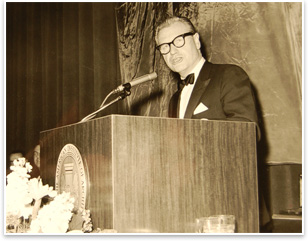 A year earlier
AIA President Robert F. Hastings had told AIA members: “Over
the years, the rhetoric on this subject has become a kind of
prideful ideology. By talking about it, you tended to demonstrate
that you were a deep thinker, well versed in the new philosophies,
one of the new breed of futurists. Yet, while you talked about
change, you privately felt unaffected by it. No longer ... The fact
is that we can no longer afford a system that discards cities and
towns and the people who live in them. We can no longer afford a
system that encourages waste, sprawl, neglect, and destruction. We
can no longer afford a system that consumes our resources faster
than we can replenish them ... The architect today, and the
Institute he [sic] directs, must now, I believe, plunge actively
into political life, enlist allies, swing votes, mobilize community
action, and take positions on issues that were once thought to be
outside our rightful area of concern.” It is almost as if
Hastings were suggesting a return to the AIA of 1900.
A year earlier
AIA President Robert F. Hastings had told AIA members: “Over
the years, the rhetoric on this subject has become a kind of
prideful ideology. By talking about it, you tended to demonstrate
that you were a deep thinker, well versed in the new philosophies,
one of the new breed of futurists. Yet, while you talked about
change, you privately felt unaffected by it. No longer ... The fact
is that we can no longer afford a system that discards cities and
towns and the people who live in them. We can no longer afford a
system that encourages waste, sprawl, neglect, and destruction. We
can no longer afford a system that consumes our resources faster
than we can replenish them ... The architect today, and the
Institute he [sic] directs, must now, I believe, plunge actively
into political life, enlist allies, swing votes, mobilize community
action, and take positions on issues that were once thought to be
outside our rightful area of concern.” It is almost as if
Hastings were suggesting a return to the AIA of 1900.
A lasting pledge to free-trade principles
In turn, 1972 also brought a challenge from the Justice Department.
Prior to 1970, the Ethical Standards of the AIA stated “An
architect shall not enter into competitive bidding against another
architect on the basis of compensation.” The Department of
Justice had contacted the AIA in 1968 noting that in its opinion
the standard was in restraint of trade and a violation of the
Sherman Antitrust Act. Because of the demonstrated concern of the
Institute’s own attorneys, no judicial action had been taken
against any member for violation of the standard since 1963.
Yet, on December 7, 1971, the Department of Justice advised the AIA
that they planned to file suit against the Institute for violation
of the Sherman Act, but offered to avoid litigation through
negotiation of a consent decree that the Institute would “not
have any ethical standard, rule, by-law, resolution, policy
statement, plan, program or course of action which prohibits
members from at any time submitting price quotations for
architectural services.”
After long discussion, the decree was approved by AIA members
assembled in convention. Settled for the moment, the question would
come back later whether the Institute had abided by the
decree.
A dearth of women in the profession
One resolution of the 1972 convention addressed to the
“Status of Women in the Architectural Profession,”
requiring the Institute to act positively to improve that status
and report to the convention on actions. Judith Edelman, who
reported, noted that the “intent of this sub-committee is not
to try to change the minds of those who believe that women should
not be architects, who would not want their wives or daughters to
be architects. That is clearly beyond the scope of the
committee’s effort. But there is a crucial difference between
the right to such personal beliefs and the right to discriminate
against those women who make the decision to be architects.”
Edelman reported that the percentage of women registered architects
seemed to hold steady at 1.2 percent of the total. “This may
be the lowest percent of any occupation short of steel workers or
coal miners.” She discussed other findings: “Unrefined as
they may be at this time, they are certainly enough to clearly
demonstrate that the alleged grievances are not all in the heads of
some paranoid chicks.”
 Four years
later, in 1976, the Institute could announce a broad affirmative
action program aimed at ending professional discrimination against
women, making such discrimination a violation of professional
ethics. In announcing the program, AIA President Louis de Moll
called it “a commitment that all of us must consciously make
not merely as a matter of conscience, nor of compliance with
governmental or other directives. If we fail to respond, we will be
shortchanging not only a great many talented and dedicated
architects and future architects. We will be shortchanging our
whole profession.” Sixteen years after that initial
resolution, the Institute would celebrate—with exhibitions,
publications, and very public events—the centennial of the
election of the first woman to the AIA, Louise Blanchard Bethune,
in 1888. Although a great deal of progress has been made, women
still are under-represented among registered architects.
Four years
later, in 1976, the Institute could announce a broad affirmative
action program aimed at ending professional discrimination against
women, making such discrimination a violation of professional
ethics. In announcing the program, AIA President Louis de Moll
called it “a commitment that all of us must consciously make
not merely as a matter of conscience, nor of compliance with
governmental or other directives. If we fail to respond, we will be
shortchanging not only a great many talented and dedicated
architects and future architects. We will be shortchanging our
whole profession.” Sixteen years after that initial
resolution, the Institute would celebrate—with exhibitions,
publications, and very public events—the centennial of the
election of the first woman to the AIA, Louise Blanchard Bethune,
in 1888. Although a great deal of progress has been made, women
still are under-represented among registered architects.
The AIA at 109: poised for change
The American Bicentennial in 1976 seems not to have been
an AIA thing, though AIA President Louis de Moll declared that the
AIA had learned from it and, disturbed by what it learned, had
“taken that all-important first step—becoming
concerned.” That concern evidenced itself in many ways,
including vocal AIA support for passage of an Energy Conservation
and Production Act, participation in a National Forum on Growth
Policy, and sponsorship of AIA Regional Urban Design Assistance Teams
(R/UDATs).
“The problems we face,” de Moll said, “don’t
need to overwhelm us. They define challenges which a vigorous,
concerned people and a new national leadership should
welcome.”
Whether the nation, at the age of 200, was learning was a question
that could be answered in many ways, but the AIA, at the age of
109, certainly seemed to be.
Copyright 2005 The American Institute of Architects. All rights reserved. Home Page

